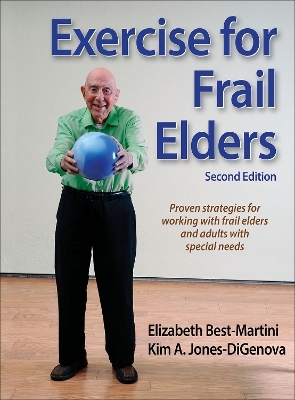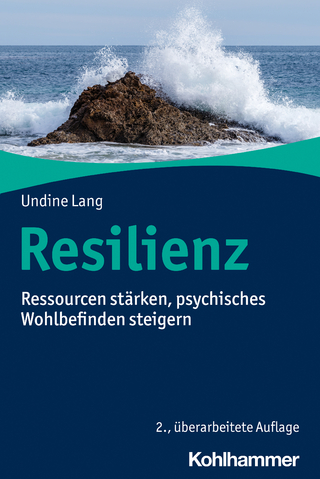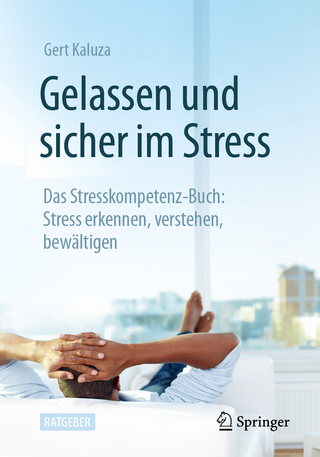
Exercise for Frail Elders
Human Kinetics (Verlag)
978-1-4504-1609-2 (ISBN)
- Lieferbar (Termin unbekannt)
- Versandkostenfrei innerhalb Deutschlands
- Auch auf Rechnung
- Verfügbarkeit in der Filiale vor Ort prüfen
- Artikel merken
As the older adult population increases, so does the demand for fitness professionals who understand the capabilities and special needs of seniors with illnesses, disabilities, chronic disorders, and sedentary lifestyles. Exercise for Frail Elders, Second Edition, is the only exercise fitness guidebook that focuses on working with frail elders and adults with special conditions. It is an invaluable resource for improving functional fitness, maintaining aspects of independent living, and enhancing quality of life.
With Exercise for Frail Elders, Second Edition, readers will gain a deeper understanding of 14 medical conditions common to older adults, how these conditions may affect participants’ ability to perform activities of daily living, and what exercises can help them maintain and increase functional fitness. This book focuses on special needs stemming from conditions including arthritis, cardiovascular disease, diabetes, hypertension, orthopedic issues, osteoporosis, Parkinson’s disease, and Alzheimer’s disease.
The updated second edition provides a broader focus on balance, a critical component of any functional fitness program, to aid in designing classes that incorporate various stability exercises. Exercises that provide significant benefits to balance are indicated with a symbol to ensure effective program design. Additional features of this edition include the following:
Learning objectives at the beginning and review questions at the conclusion of each chapter provide a framework for understanding.
Reproducible forms provide readers with easy-to-use appraisals, questionnaires, and exercise logs for evaluating clients.
Checklists and reference charts highlight key areas of concern and consider specific needs when planning functional fitness programs for clients.
Guidelines and safety precautions for special conditions and how they apply to range-of-motion exercises, resistance training, aerobic exercise, and stretching have been updated.
Specific exercise instructions, including variations and progression options, show professionals how to add interest and challenge for participants.
Suggested resources encourage exercise leaders to continue their education.
To enhance learning and program development, the text is divided into two parts. Part I covers planning an exercise program for frail elders or adults with special needs, including knowing the needs of class participants, motivating students to exercise, and keeping them safe while participating. It also offers strategies for success, including basic class structure creating a sense of fun and community. Part II covers implementation of a successful program, including course design, warm-up and cool-down, and exercises for range of motion, resistance training, aerobic training, and stretching, with their variations. Over 150 photos illustrate safe and effective execution of the exercises.
Exercise for Frail Elders, Second Edition, is an easy-to-follow resource for working with elderly individuals in assisted living and nursing homes, rehabilitation facilities, hospitals, day centers, senior centers, recreation and community centers, and home health care environments. This unique guide has the hands-on information necessary for creating safe and effective exercise programs and understanding medical disorders, safety precautions for specific disorders, and implications for exercise. Readers will learn to design and teach a dynamic fitness program for older adults—and keep it fun, safe, and functional—with Exercise for Frail Elders.
Elizabeth (Betsy) Best-Martini, MS, CTRS, is a certified recreational therapist specializing in the field of fitness, aging, wellness, and long-term care. Best-Martini is the owner of Recreation Consultation, a firm that provides training and recreational therapy consultation to retirement communities, skilled nursing settings, subacute settings, and residential and assisted care facilities in northern California. Her practice also includes Fit For Life one-to-one personal training for adults and older adults. Best-Martini specializes in working with adults with special needs and brings more than 30 years as a rehabilitation therapist to this work. In addition to consulting, she lectures and provides training across the United States and in Canada. She also teaches a weekly seated strength training class in an assisted living setting. Best-Martini is an instructor at the College of Marin in Kentfield, California, where she teaches courses in strength, flexibility, and balance for adults and older adults. She trains new fitness instructors in the Exercise for Adults with Special Needs Fitness Instructor Training and Certification course through the American Senior Fitness Association. In addition, she facilitates the Activity Coordinator Training course, which certifies students through the Department of Public Health to become activity coordinators working with older adults and frail elders. She has authored two other texts, Long-Term Care for Activity Professionals, Social Services Professionals, and Recreational Therapists, Sixth Edition, and Quality Assurance for Activity Programs. Best-Martini also writes a column focusing on fitness and wellness programs for older adults in Creative Forecasting, a national newsletter for activity professionals and recreational therapists. In 2006 and 2008, Best-Martini received the American Therapeutic Recreation Association (ATRA) Member of the Year Award. She was awarded the 1998 Distinguished Merit Award from the Northern California Council of Activity Coordinators (NCCAC) and the Pete Croughan Award for her volunteer efforts with the nonprofit organization, Love Is The Answer (LITA). She also served on the Visionary Advisory Board for the International Council on Active Aging (ICAA). In her free time, Best-Martini can be found gardening, hiking, exercising, and spending time with her husband, family, and many pets. She lives in Fairfax, California. Kim A. Jones-DiGenova, MA, received her master’s degree in physical education (exercise physiology) and the Distinguished Achievement in a Major Field Award from San Francisco State University. She is a physical education instructor at the College of Marin in Kentfield, California, where she teaches courses on strength and fitness training for older adults. She also serves as a health and fitness consultant and personal trainer in the San Francisco and San Rafael metropolitan areas. Jones-DiGenova has been working in the fitness field since 1971. She is an ACSM-certified health fitness specialist; SFA-certified senior personal trainer, senior fitness instructor, and long-term care fitness leader; Arthritis Foundation exercise program instructor; and YMCA strength training instructor trainer. She is the Northern California academic administrator for the American Senior Fitness Association and has developed and implemented resistance training programs in several convalescent, retirement, and senior facilities throughout California. Jones-DiGenova has also assisted handicapable adults with weight training, aerobic exercise, and stress reduction at the Recreation Center for the Handicapped in San Francisco. In addition to her work on Exercise for Frail Elders, Jones-DiGenova is a regular contributor to national and local newsletters. Jones-DiGenova resides in Novato, California. She enjoys spending time with family and friends and reading. She stays active by walking, hiking, swimming, weight training, and practicing yoga. She has swum from the Golden Gate Bridge to the San Francisco–Oakland Bay Bridge and has successfully escaped from Alcatraz many times. Janie Clark, MA, is president of the American Senior Fitness Association (SFA), the international organization for fitness professionals who serve older adults. She earned a master’s degree in exercise physiology and wellness management from the University of Central Florida, with an emphasis in older adult health and fitness. Clark is a contributing author of Physical Activity Instruction of Older Adults and Exercise for Older Adults: ACE's Guide for Fitness Professionals. She is the author of Brain Fitness for Older Adults: How to Incorporate Cognitive Fitness Into Physical Activity Programming; Quality-of-Life Fitness; Seniorcise: A Simple Guide to Fitness for the Elderly and Disabled; Full Life Fitness: A Complete Exercise Program for Mature Adults; and Exercise Programming for Older Adults. She has authored hundreds of articles for periodicals, including the Journal of Aging and Physical Activity; Activity, Adaptation & Aging Journal; ACE Certified News; and Modern Maturity. Janie served on the National AFib Support Team sponsored by Sanofi-Aventis pharmaceutical corporation to provide patients and health care professionals with current information on atrial fibrillation. She also served as a reviewer for the LifeSpan project, which developed functional fitness tests for older adults, and as a member of the Coalition to Develop National Curriculum Standards for Senior Fitness Professionals. Clark resides in Florida with her husband, son, and ever-growing menagerie of cats, dogs, and other furry creatures.
Part I Planning a Successful Exercise Program for Frail Elders and Adults With Special Needs
Chapter 1. The Participants: Know Their Individual Needs
Frailty and Special Needs in Older Adults
Common Medical Disorders and Special Needs
Summary
Review Questions
Chapter 2. The Exercise Program: Make It Motivating, Safe, and Effective
Wellness and the Wellness Model as a Tree
Make It Motivating
Make It Safe
Make It Effective
Summary
Review Questions
Chapter 3. The Leader: Tips and Strategies for Success
Creating a Sense of Fun and Community
How to Set Up a Group Exercise Class
Opening Your Exercise Class
Leading Your Exercise Class
Closing Your Exercise Class
Summary
Review Questions
Part II. Implementing an Exercise Program for Frail Elders and Adults With Special Needs
Chapter 4. Warm-Up: Posture, Breathing, Range-of-Motion, and Stretching Exercises
Safety Precautions
Guidelines
Basic Seated Warm-Up Exercises
Basic Standing Warm-Up Exercises
Variations and Progression
Summary
Review Questions
Illustrated Range-of-Motion Instruction
Chapter 5. Resistance Training
Myths
Safety Precautions
Guidelines
Basic Seated Resistance Training Exercises
Basic Standing Resistance and Balance Exercises
Variations and Progression
Summary
Review Questions
Illustrated Instruction
Chapter 6. Aerobic Training and Dynamic Balance Activities
Safety Precautions
Guidelines
Basic Seated Aerobic Exercises
Basic Standing Aerobic Exercises
Variations and Progression
Summary
Review Questions
Illustrated Instruction
Chapter 7. Cool-Down: Stretching and Relaxation Exercises
Safety Precautions
Guidelines
Basic Seated Cool-Down Exercises
Basic Standing Cool-Down Exercises
Variations and Progression
Summary
Review Questions
Illustrated Stretching Instruction
Chapter 8. Putting Your Exercise Program Together
Designing Your Exercise Program
Scheduling Your Exercise Classes
Modifying the Exercises
Progressing Your Exercise Class
Maintaining Fitness Results
Monitoring Attendance and Progress
Summary
Review Questions
| Verlagsort | Champaign, IL |
|---|---|
| Sprache | englisch |
| Maße | 216 x 279 mm |
| Gewicht | 1111 g |
| Themenwelt | Sachbuch/Ratgeber ► Gesundheit / Leben / Psychologie ► Lebenshilfe / Lebensführung |
| Sachbuch/Ratgeber ► Sport ► Fitness / Aerobic / Bodybuilding | |
| Schulbuch / Wörterbuch ► Lexikon / Chroniken | |
| Medizin / Pharmazie ► Medizinische Fachgebiete ► Sportmedizin | |
| ISBN-10 | 1-4504-1609-8 / 1450416098 |
| ISBN-13 | 978-1-4504-1609-2 / 9781450416092 |
| Zustand | Neuware |
| Haben Sie eine Frage zum Produkt? |
aus dem Bereich


